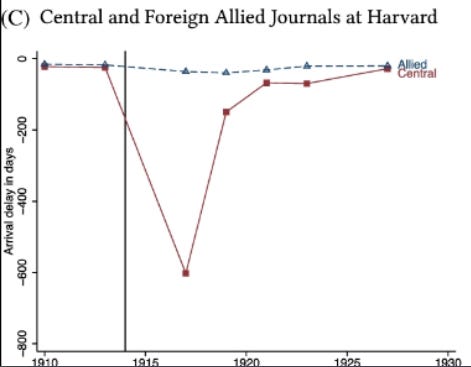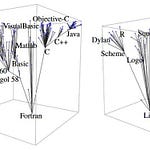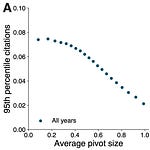Like the rest of New Things Under the Sun, this article will be updated as the state of the academic literature evolves; you can read the latest version here.
Here’s another obvious idea that turns out to work: if you want more technological innovation, more science helps.
That probably shouldn’t come as a surprise: lots of inventors (not all!) say in surveys that science is an important input to their inventions and about a quarter of patents in 2018 directly cite scientific papers. And we can think of countless examples of technologies with their roots in fundamental scientific advances. But none of that necessarily means that investing in more science will lead to more innovation. For example, maybe some inventors intensely rely on a tiny sliver of useful science, but the bulk of scientific work never leaves the ivory tower. And maybe we already do science that’s most likely to be useful, so that any additional science will be of the latter variety.
To see if that’s the case, we can turn to a few examples where scientific production in some fields either increased or decreased unexpectedly, and then see what happens to technology that tends to rely on that science, relative to other technologies. As we’ll see, when you increase or decrease scientific output in a field, that tends to respectively increase or decrease the use of science in related technological domains.
Geopolitical Shocks to Science
Let’s start with a geopolitical shock that decreased science, rather than increased it: World War I. Leading up to World War I, science had increasingly become an international endeavour, with scientists reading articles published all over the world and meeting frequently at international conferences. This all changed, however, when the world split into the Allied powers, the Central powers, and the Neutral states in World War I. Iaria, Schwarz, and Waldinger (2018) show that the onset of war led to huge delays in the receipt of new scientific journals from countries belonging to a scientist’s enemies. For example, here is how the gap between a journal’s publication and arrival in the Harvard library evolved over 1910-1930 for journals published in Central power countries and Allied countries (which the USA was a part of).
As the figure above indicates, delivery of articles from Central power scientists to the USA got delayed for nearly two years during the war, while articles from allied nations saw barely any delay at all. The Central powers saw similar delays of receipt of Allied power journals. Or consider the following image of attendees to the famed Solvay conferences for top international physicists. We can note two things. First, the absence of any conference at all between 1913 and 1921. Second, even after hostilities ceased, things did not return to their pre-war norm. The circled faces belonged to Central power scientists: note their absence between 1921 and 1927.
Iaria, Schwarz, and Waldinger also show a substantial drop in citations to articles published by scientists from the “other side” during this period. And lastly they show, using text similarity analysis, that the titles of journal articles (after being translated into English) began to become less and less similar between scientists on opposite sides during the war.
Taken together, it’s clear the war cleaved the large international scientific community into two smaller ones. But the impact was different across fields and countries. In some cases, for example, US biology, there wasn’t much of a disruption at all, because the field tended to rely on domestic or allied research. But in others, like US biochemistry, scientists heavily cited and used work produced by Central power scientists, to which they no longer had ready access once the war began. Iaria, Schwarz, and Waldinger compare the effect of this disruption for science fields and countries that relied heavily on outside science to those that didn’t.
They show that scientists in fields that most regularly cited top articles by scientists from the other side produced fewer publications than scientists who were not so reliant on foreign science. Moreover, the quality of the work they did publish was also reduced. For example, scientists in these fields saw a reduction in the probability they would produce work good enough to be nominated for a Nobel prize.
Most importantly for the purposes of this post, Iaria, Schwarz, and Waldinger have an interesting way to track linkages from science to technology by looking for new and novel words that first appear in the titles of scientific articles, and later appear in US patents. These words included things like “magnetron” or “electroencephalogram.” As a general rule, on average every year a scientist in their dataset produces new words that pop up in the text of 0.43 patents down the road. However, scientists most reliant on top foreign science tended to produce fewer of these technological/scientific words once they were unable to access science from abroad.
In short, it seems a reduction in science caused by wartime disruption to knowledge flows reduced the production of new scientific ideas that would normally have been picked up and used in patents in later years.
That was a long time ago and World War I was a very unique event; but the results are pretty similar to a more recent geopolitical shock that affected research differently across different fields.
Arora, Belenzon, and Suh (2021) is not primarily concerned with how science leads to technology, but instead documents myriad ways that science facilitates trade in patented technology. But for the purposes of this post, we’ll focus on a part of their study where they identify another scenario where funding unexpectedly changes for different fields. In their case, they use the unexpected collapse of the USSR and the end of the Cold War as a surprise shock to US science funding. The end of the Cold War resulted in a significant reallocation of US federal R&D dollars away from areas like defense and defense-related sciences such as physics, chemistry, and electrical engineering, and towards new scientific areas like computer science, oceanography and biology. Arora, Belenzon, and Suh show that these shifts in funding had the kind of effect you would anticipate - more funding led to more scientific papers in some fields and less funding led to fewer papers in others, relative to the counterfactual. Since the collapse of the USSR and subsequent reshuffling of research dollars was an unexpected event, if you’re a private sector research firm in the early 1990s, from your perspective there was a sudden windfall of new research in some fields and a deficit in others, relative to your expectations.
Arora, Belenzon, and Suh show that technologies that typically relied on research from the sciences that benefited from the end of the Cold War responded by citing that research more often. The share of patents citing scientific papers was correlated with the surge (or decline) of scientific papers brought about by reallocation of research dollars. And in other parts of their paper, they confirm previouswork that patents citing scientific research tend to be more valuable by a variety of metrics. Patents citing scientific research:
Receive more citations from other patents
Are more likely to be bought and sold
Lead to a larger increase in the stock market valuation of the firms owning them
In short, the end of the Cold War disrupted different science fields in different ways; some fields got more funding and generated more research, others the opposite; technological fields associated with the “winning” fields cited more research when more became available; and the patents that cite science look to be more valuable.
The Benefits of Science Funding Windfalls
Both of the above papers use massive geopolitical shocks to document how big changes to the production of science get reflected in technology down the road. But while they are very suggestive, they don’t exactly attempt to show that more science necessarily leads to more technology. Instead, they show that a decline in science leads to a reduction in the use of science by technology, and an increase in science leads to an increase in the use of science by technology (and also that more science-based technology seems to be more valuable). But two other papers look at much smaller scale changes in science production to show more explicitly that increasing the production of science tends to increase technological innovation as well.
To start, let’s look at a clever 2019 paper by Tabakovic and Wollman about football and scientific research. One peculiarity of the US university system is that for some schools a non-negligible share of university revenues come from college football. For universities in the NCAA, when their team does unexpectedly well, the university receives windfall funding from licensing broadcast rights, merchandise, and alumni fundraising. The amounts can be quite large - football revenues are equal to more than a third of tuition revenue at Louisiana State University. Much of this funding finds its way into supporting university research in the subsequent year.
Tabakovic and Wollman exploit this idiosyncracy in US funding mechanisms to identify universities that receive unexpected research dollar windfalls. Specifically, they look at how university support for research changes when teams outperform or underperform preseason expectations as measured by votes in the NCAA top 25 AP poll. As the left-most panel in the figure below indicates, universities that outperform expectations (receive more votes in the poll at the end of the season than at the beginning) get more institutional funding for research in the following year. Meanwhile, the other two panels serve as a bit of a sanity check; they indicate football performance has no impact on the receipt of federal grants or other forms of funding, which is what we would expect.
What happens when researchers get more money? Tabakovic and Wollman estimate that a 10% increase in funding is associated with 3% more publications in the following year. And it turns out the funded science also leads to patents: they find about $2.6mn in funding for university research is associated with about one more patent. Lastly, they can use the revenue the university earns by licensing out these patents to get a rough estimate on whether the patents are valuable enough for a private sector firm to pay for access to them. And they are - a 10% increase in funding is associated with at least a 10% increase in licensing revenues.
Those estimates are noisy, but they’re more-or-less consistent with one of my favorite recent studies, which also exploits a similar special case when funding is more-or-less randomly handed out to different groups of scientists.
Azoulay et al. (2019) want to know how NIH funding for basic biological research eventually leads to private biomedical innovation. To measure biomedical innovation, Azoulay and coauthors identify a large set of biomedical patents. The pharmaceutical sector relies on patent protection to an unusually large degree, and so for this sector patents tend to be a better measure of actual innovation than might be the case for other sectors. They then go on to link these biomedical patents to journal articles via citations. They then go a step further and link journal articles to grants from the NIH. This lets them see in unusual detail the entire pipeline from funding for basic research to technological innovation. They can see if more NIH funding is associated with more journal articles, and more journal articles is associated with more patents, with each link in the chain observable with direct citations. And it is! In general, an extra $10mn for a given disease-science area is associated with 2.6 more related patents. That’s $3.8mn per patent, which is not too different from what Tabakovic and Wollman find.
This finding holds even when you include lots of control variables, such as scientific field-specific variation over time. For example, maybe gene sequencing technology means genetic studies get a lot more bang for their buck than in the past, and the federal government responds by giving more grants to scientists proposing genetic research. In principle, we might worry that inflates the apparent value of funding, since the fields that get more money were more likely to generate valuable knowledge even if they got less money. But in that case, Azoulay et al. (2019) show their results still hold when you compare within this scientific area at the same point in time. That is, even comparing two different proposals, relying on the same science at the same time, the one that gets funding (for one disease) is associated with more patents then the one that doesn’t (and which is associated with a different disease).
But the paper goes further than that. Azoulay and co-authors exploit idiosyncrasies in funding to get plausibly random variation in which grants are funded and which are not. To simplify, it’s kind of like this: all grant proposals belong to both a scientific area and a disease area. Proposals are scored by scientific committees. These scientific committees review proposals associated with several different diseases, as long as they are in the same scientific area. But then proposals are handed off to be funded or not based on how well they rank compared to other proposals for the same disease - not the same science.
That means you can have situations like the following. Suppose one proposal scores very well (say, an 8/10), but because the other proposals in the same scientific area are even better, it gets a low ranking from it’s science committee (say, ranked 5 out of 5). Meanwhile, in another scientific committee, another proposal faces the opposite situation: it is poor quality and gets a poor score (say, 4/10), but since the other proposals are even worse, it gets a high ranking from its science group (say, ranked 1 out of 5). If both these proposals belong to the same disease group, you can end up with a situation where the weaker proposal might get funded simply because it had a higher ranking. But that ranking is less due to the proposal’s inherent quality than it is to the quality of the other proposals in its same scientific area.
Azoulay and coauthors look at the 10 proposals that straddle the funding cut-off for a given disease group; 5 are above the cut-off and get funded, 5 are below and don't. Down towards this cutoff, the uncertainties discussed above loom large and whether a given proposal lies above or below this threshold is largely a matter of luck. The authors create measures of "windfall" funding based on whether a disease-science area has more than 50% of it's proposals lying above or below this cut-off. In that way, they can see what happens to innovation in scientific fields that got a couple extra million dollars of grant money, compared to those that just missed out. Using this more complicated approach they find basically the same thing - a random extra $10mn results in about 2.3 more related patents. But in this case, we can more confidently assert the relationship is causal: (biological) science leads to (biomedical) innovation down the road.
Beyond Patents?
So, to sum up:
Scientific fields more disrupted by war produced fewer new scientific words that go on to show up in patents than less disrupted fields
Scientific fields that benefited from the restructuring of R&D during the end of the cold war produced more papers, which got cited by more technologies that typically rely on science from those fields, and in general patents citing science tended to be higher quality
Universities that got windfall funding on the unexpected strength of their football teams produced more papers, patents, and technology licensing revenue
Science-disease areas that received more funding due to idiosyncrasies in NIH funding rules produced more papers (which explicitly acknowledge grants support), and more patents (which explicitly cited these papers)
And there’s one more line of supporting evidence. One potential downside of all these papers is that they rely on patents to measure technological innovation. The strength of patents in this case is they provide such detailed data in the form of citations, text, and licensing fees that we can really nail down the link between science and technology. But at the same time, patents are a highly imperfect measure of technological innovation. But if we’re willing to look at messier correlational data, we also have some correlational data on R&D and measures of industry-wide total factor productivity. Higher levels of basic R&D tends to be associated with higher productivities in related industries with a lag of about 20 years (a lag that happens to match reasonably well the lags between patents and the research they cite).
Taken all together, in addition to our prior beliefs that modern technology relies to a large degree on better science, it makes a pretty compelling case. More science tends to lead to more innovation. It’s not the only thing that leads to more innovation, and it doesn’t lead to innovation in all fields, but it does work.
If you liked this post you might also like:
How useful is science? (answer: pretty useful!)
Does chasing citations lead to bad science? (answer: not for the most part)
How long does it take to go from science to technology? (answer: 20 years is a good rule of thumb)










